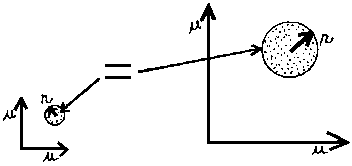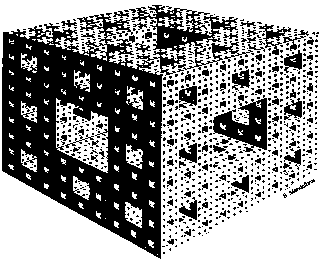home
contents Mathematics
the measurement of the deformation of a contrast
the trap in the vectorial representation of the forces
home |
contents Mathematics |
previous
: the measurement of the deformation of a contrast |
next
: the trap in the vectorial representation of the forces |
| direct to all other pages of the section ----> | 00 | 01 | 02 | 03 | 10 | 11 | 12 | 20 | 21 | 30 | 31 | 32 | 33 | 34 |
'In theory'
the dimension of a contrast can be self-similar
| The example of the spotted sheet
has a limit: you do not always measure
the same contrast dimension, even on the same surface, even
with the same distribution of spots.
There is no 'trick' to correct the result according to the scale of the measurement, and to always pick the same result. |
 It's
not the same thing with the coordinate dimensions: you can
look from far away or from nearby, they always measure the same dimensions.
We only have to adapt the measurement scale to the reading scale. It's
not the same thing with the coordinate dimensions: you can
look from far away or from nearby, they always measure the same dimensions.
We only have to adapt the measurement scale to the reading scale. |
The
same thing fits to the deformation dimensions, only if they have a special
characteristic: they have to be self-similar, that is, similar to themselves
in all scales.
To take again the example of the
spots, the size and the organization of the spots should be coordinated,
so that the spots we see from far away, appear when seen more closely,
as made of smaller spots, which themselves when seen even more closely,
etc., from the infinitely great to the infinitesimal. Of course, the proportion
between black and white should also be the same in every 'spot level'.
In practice, it cannot be so, for
we cannot divide a spot infinitely.
But theoretically, that's possible.
And in fact, it does exist.
- a 'Cantor-dust'
fits with this definition. That's a line whose central 1/3 is removed,
and on each remaining 1/3, the central 1/3 is removed, and so on infinitely.
- a 'Sierpinski-carpet'
as well. That's a square whose central square is removed, then on every
square in what the remain can be split up, we remove the central square,
etc.
- a 'Menger-sponge'
too. That's the same thing than the 'carpet', but with cubes instead of
squares.
 a
'Cantor-dust'
a
'Cantor-dust'
a 'Sierpinski-carpet'
 a 'Menger-sponge'
a 'Menger-sponge' |
| So, we have made a little progress
to define a deformation dimension.
- first,
we saw how a deformation could have a value, without any notion of coordinates.
|
home |
Math |
top |
next
: |
author |